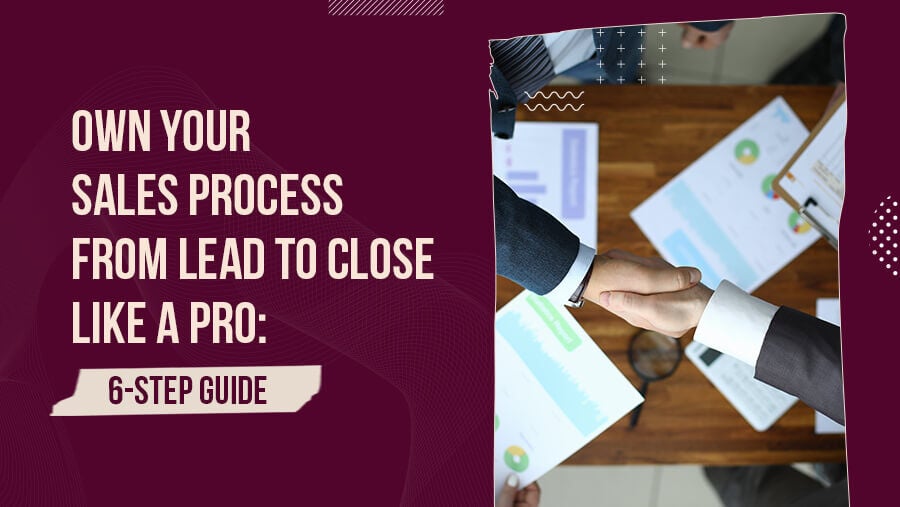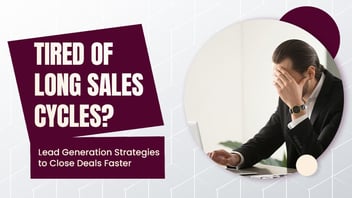
Own Your Sales Process From Lead to Close Like a Pro: 6-Step Guide
What’s one of the significant challenges most sales reps and AEs face? It's probably designing a scalable ‘lead to close’ process that generates consistent repeat business.

For your business to stay a step ahead, you must be strategic. With so many competitors out there, it takes time to stand out. Therefore, you must take charge and build a solid sales process from lead to close to see better results.
A staggering 73% of buyers believe salespeople need help understanding their company's requirements.
Hence, to help you, we decided to develop our 6-step guide. Our tutorial is designed to guide you in mastering your 'lead to sales' process.
It provides a step-by-step roadmap – from generating leads to closing deals. As such, you can take ownership of your B2B marketing and sales framework.
Here, you'll learn how to define your ideal customer and develop a targeted lead gen strategy. Additionally, you'll understand how to generate and qualify leads and more.
Once you master these concepts, you'll be able to foster stronger relationships with potential customers.
And you can close more deals, ultimately driving revenue for your business.
So why wait? Let's dive right in!
Before moving on, let’s understand why you should master your ‘lead to sales’ process:
- Allocating resources efficiently: When you know the exact steps that lead to a successful sale, you can assign responsibilities accordingly. It removes duplication of effort and wasted time. Hence, you can focus on other critical business areas.
- Identifying bottlenecks: You can determine where your sales process is stalling or where potential customers are dropping off.
This insight can help you determine which part of the sales funnel requires the most attention, such as improving your lead generation, qualification, or sales lead nurturing process.
By pinpointing these bottlenecks, you can develop targeted strategies to address them and improve your overall sales performance.
- Focusing on qualified leads: You can identify the leads most likely to convert into customers.
With this knowledge, you can focus on finding more qualified leads and devote resources to that specific sales cycle stage.
This can help you improve your sales leads conversion rates and increase your revenue.
Additionally, having a defined ‘lead to sales’ process simplifies the onboarding process for new staff. How?
- You can give your new staff a clear outline of short-term and long-term goals.
- Also, recruits know how each stage of the cycle supports the next.
- Thus, new hires can quickly understand their marketing and sales roles.
Moreover, you can recognize areas where you're wasting resources.
Eliminating low-return projects and shifting your team's focus to high-yield efforts can save time, money, and effort.
For example, you might discover that your team excels at generating leads but struggles to make contact. Identifying this issue enables you to provide training on overcoming the related obstacles.
These may include writing better emails or getting past gatekeepers.
6 Steps in the Sales Process from Lead to Close
Let’s now discuss the six stages of the sales process from lead to close.
Step 1: Define Your Ideal Customer
Step 2: Develop a Targeted Lead Gen Strategy
Step 3: Generate Leads
Step 4: Qualify Leads
Step 5: Nurture Leads
Step 6: Close the Deal
Step 1: Define Your Ideal Customer
Identifying your ideal customer is a critical first step in creating a successful lead-gen process. It helps you focus your efforts on customers most likely to buy from you, saving you substantial hours, cash, and effort.
Businesses that target their ideal customers have higher customer retention rates.
Here's an example of profitable ideal customers in the software industry:

They can offer a more personalized experience that meets the client's specific requirements, and consumer retention is critical. Why?
The probability of selling to an existing customer is between 60% and 70%. But, the likelihood of selling to a new buyer is only between 5% to 20%.
So, how do you identify your ideal client? One approach is to start with a customer profile.
- Look at your current buyers and identify the most profitable ones.
- Also, select the ones that have the highest customer lifetime value.
- Pinpoint the characteristics that they have in common.
Additionally, you can survey your existing consumers to gather more information about their preferences. It helps you identify patterns and trends that inform your ideal customer profile.
Once you have a clear understanding of your ideal customer, you can tailor your:
- Messaging
- Marketing campaigns
- Product offerings
–to better meet their needs.
It will help you attract ideal customers and increase the chances of converting them into paying buyers.
Step 2: Develop a Targeted Lead Gen Strategy
It's crucial to tailor your lead gen strategy to your ideal customer. Doing so can create a targeted approach that better resonates with your potential clients, making them more likely to convert into paying customers.
One advantage of developing a targeted strategy is that it allows you to focus on your client's specific pain points. By understanding what motivates your ideal client, you can craft a messaging strategy that speaks directly to their concerns.
Additionally, a tailored approach enables you to create personalized experiences for your potential clients. For instance,
- You can develop content that speaks to their specific needs.
- You can also offer customized solutions based on their unique requirements.
These personalized touches can increase the chances of securing a sale. Now, one way to develop a custom framework is to do your research:
- Learn about your ideal customer's demographics, psychographics, and preferences.
- Use that information to develop a messaging strategy directly addressing their pain points.
Another approach is to analyze the buying patterns of your ideal customer:
- First, understand the steps they take before making a purchase.
- Following that, you can develop a sales strategy that caters to their needs at each stage of the buying process.
Step 3: Generate Leads
Next, how do you attract potential customers? Our recommendation is the very cost-effective and result-oriented technique – outbound marketing. It involves actively reaching out to potential customers through channels such as:
- Cold calling
- Direct mail
For example, you can contact a targeted list with a personalized email. The messaging can highlight how your product or service can solve a problem. By doing this, proactively seek out potential customers and start a conversation with them.
You can also use lead magnets to entice prospects. Lead magnets are valuable resources. These may include whitepapers or ebooks you offer in exchange for a prospect's contact information. You can build a database of potential customers interested in your product/service.
Finally, measuring the success of your lead generation efforts is essential. Start by tracking metrics such as:
- Email link clicks
- Email open rates
- Conversion rates
Then, you can determine which strategies are working and which ones need improvement.
Step 4: Qualify Leads
Once you have generated a pool of leads, pre-qualifying leads is crucial to determine which will most likely become paying customers. However, here's a shocker.
- Around 61% of B2B marketers send all leads directly to sales.
- But, as per the same source, only 27% of those leads are qualified.
That means a lot of wasted resources for your sales team.
To avoid this, you can use a lead scoring system. It involves assigning scores to each lead – so that you can identify the most promising prospects. Here are the steps involved:
- Define lead scoring criteria: Identify the characteristics of a qualified lead. You can use explicit, implicit, and negative criteria to categorize and prioritize leads based on their conversion likelihood.
- Create a lead scoring framework: Assign weights to each lead based on their behavior and demographic data. It helps determine which leads are "hot" and ready for sales follow-up.
- Establish a scoring threshold: Understand your business goals and analyze past sales data. It will help you set an initial threshold and refine it based on your results.
Here's an example of a lead scoring model that includes:
- Explicit criteria: Job title and industry
- Implicit criteria: Website visits and resource downloads
- Negative criteria: Opting out of email communications


By setting up a lead scoring framework like this, you can allocate your team resources more efficiently and focus on the leads most likely to convert into customers.
Establishing a clear definition of a qualified lead is also essential. Your sales and marketing teams must agree on it.
- It ensures everyone is on the same page.
- Moreover, it helps guarantee that leads are passed to sales appropriately.
Finally, consider using a CRM or other tools to manage and track your leads. This will help you stay organized and efficient in your lead qualification process.
Step 5: Nurture Leads
A lead nurturing process involves building relationships with your leads.
Doing so increases your chances of converting them into loyal customers. It requires time, patience, and dedication.
One effective way to nurture your leads is through email marketing.
- According to a study by Campaign Monitor, email marketing has an average ROI of 4400%.
- Additionally, 174% more conversions happen over email than on social media.
The above stats prove that email is one of the most effective marketing channels. Additionally, by sending personalized emails with valuable content to your leads, you can keep them engaged and interested in your brand.
In addition to email marketing, you can use social media to stay at the top of your mind with your leads. You can provide your leads with valuable content that keeps them engaged with your brand by regularly posting:
- Updates
- News
- Industry insights
It helps to position you as a thought leader in your industry and builds trust with your leads.
Another effective way to nurture your leads is by offering personalized content.
- By tailoring your content to your leads' needs, you can provide them with an engaging and relevant experience.
- It could include sharing case studies or success stories that demonstrate the value of your product or service.
Nurturing your leads effectively can move them through the sales funnel and closer to a sale. It also helps you build a loyal customer base that will provide ongoing revenue and help grow your business over time.
Step 6: Close the Deal
The final step in your ‘lead to close’ process is closing the deal. To ensure the deal gets closed,
- You need to present your proposals effectively.
- You also have to handle any objections raised by the potential customer.
According to HubSpot research, 69% of buyers are likelier to accept a meeting with an SDR (Sales Development Representative) who presents a personalized proposal.
It highlights the importance of creating a customized offer that suits your potential customer's needs. It also stresses the importance of comprehending the contract's terms and conditions. After that, negotiate the points to ensure both parties are happy with the agreement.
Always remember to follow a straightforward and effective process for closing deals. You can only convert leads into loyal customers and achieve a higher sales conversion rate.
Note: A good salesperson knows when to push the potential customer toward the deal and when to take a step back.
The Way Forward
Building and closing your ‘lead to sales’ process requires careful planning and execution. But, by following our six steps, you can increase your chances of converting leads into loyal customers.
Consider partnering with Revnew to streamline this process and make it more efficient. We’re a sales enablement platform that helps businesses achieve their sales goals.




